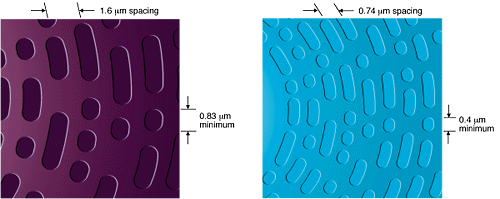| Extremely
Dense with Much Capacity
DVD, popularly know as the Digital
Video Disc (it really means Digital Versatile Disc), is the next generation of optical
disc media.
Though a DVD looks like a CD, inside it
holds between 7 and 25 times the data. That means a new level of quality and convenience
for movies, music, multimedia and interactive software. Never before has one new
technology changed so many aspects of home entertainment.
Minimum Seven Times the Data of
a CD
DVD achieves its huge capacity
by packing more data into the same physical space as a CD. It does this in several ways.
First, it's tracks are closer together and the pits in each track are smaller. Second, new
data compression technology is highly efficient, minimizing the need to store repetitive
of unneeded data. Third, two separate layers of tracks can be combined into a single DVD
disc.
For movies, this adds up to a
minimum of 2 hours and 13 minutes of video play. A dual-layer disc provides 4-hour play,
and doesn't need to be turned over. A single layered double-sided disc provides about 4
hours and 30 minutes.
Longer playing times are only
the most obvious advantage. DVD's huge capacity also supports ultra-realistic picture
quality and hi-fi sound not to mention interactive multimedia enhancements.
All the Advantages of an
Optical Disc
Like a compact disc or laserdisc, DVD
permits random access to any point on the disc. There's no need to shuttle forward or
backward through a tape, and of course there's no rewinding. As an optical disc, DVD never
physically contacts the pickup. The disc is played by a beam of laser light, so there is
no wear and tear even if you keep replaying the same scene. The tough plastic surface is
forgiving of fingerprints, dust and dirt. Care is the same as for compact discs - no
special treatment needed. This means that you can play your DVD collection thousands of
times and continue to enjoy the same beautiful picture and sound quality.
How is it Different from CDs?
On the outside, a DVD is virtually
indistinguishable form a CD. It has the same 5" diameter and 1.2mm thickness. Like a
CD, it's easy to carry, safe to handle, and is just the right space-saving compact size
for home entertainment. The only difference is the format and the amount of information.
Smaller Pits, Narrower Track Pitch Inside
On the inside, a DVD is totally
different. Its pits are half the size of CD pits (0.4µm vs. 0.83µm), and it's tracks are
spaced about twice as closer together (0.74µm vs. 1.6µm). See following
image...
| Compact Disk |
DVD Disk |
 |
Thin-Substrate
Bonded Disc
In a CD player, the laser bean has to pass through a relatively thick layer of plastic to
reach the data pits. To help a DVD player focus on its smaller pits, a DVD disc uses a
thinner plastic substrate. By itself, such a thin disc would not stay flat or withstand
handling. Therefore, every DVD is joined to a second 0.6mm substrate, using bonding
technology developed by Panasonic. On a single-layer disc, one of the two substrates has
no recorded data.
|
